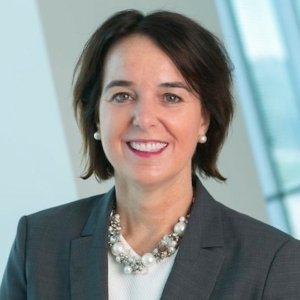Connect with Us
602 Park Point Drive, Suite 225, Golden, CO 80401 – +1 303.495.2073
© 2025 Medical Affairs Professional Society (MAPS). All Rights Reserved Worldwide.
Has Medical Affairs Solidified its Position as a Third Strategic Pillar?



Medical Affairs describes itself as a third strategic pillar in the biopharmaceutical and MedTech industries alongside R&D and Commercial. But is this truly the case or is Medical Affairs’ strategic role still aspirational? And if it is in some ways aspirational, what does Medical Affairs need to do in order to truly achieve its position alongside R&D and Commercial? Here, three Medical Affairs leaders discuss these questions and offer their perspective for the future of the function.
Charlotte Kremer: 00:00:03:08 – 00:00:58:12
Hi. I’m Charlotte Kremer. I’m the Head of Medical Affairs at Astellas and also Chair of the Board of Directors for MAPs. We’re here at the Global Annual Meeting in New Orleans. We had a fabulous activity last night already in the parade through Bourbon Street, which was a great event and reflective of the great culture we have at MAPS, but we also work hard. This will be a discussion on Medical Affairs as the third strategic pillar in pharmaceutical industry. Before we start, I would like to give the floor to Bjorn and Danie to introduce themselves and tell a little bit about their background. And Bjorn, by the way, it’s great to see you. We have not seen each other since 1997. So, 25 years ago we worked together at the same company. That is what MAPS is. All reconnecting with old friends and creating new friends. So, welcome to the community and the members family. So, Bjorn, maybe you can start with an introduction.
Bjorn Oddens: 00:00:58:19 – 00:01:32:05
Thank you, Charlotte. It’s great to see you again after all these years. I have now been in the United States for three weeks, and I’m the Head of Medical and Scientific Affairs at Merck. And my background, I trained as a medical doctor, as a clinical epidemiologist, did epidemiological research for many years. And then I moved into roles like Country Medical Director, Region Head. My last role at Merck was Head of the International Markets for Medical Affairs and since earlier this year, I’m the head of the Global Medical Affairs Organization.
Charlotte Kremer: 00:01:32:08 – 00:01:38:03
Congratulations, Bjorn. And we need to capture you in all the activities we do for MAPs. So, be prepared.
Bjorn Oddens: 00:01:38:07 – 00:01:38:35
Thank you.
Charlotte Kremer: 00:01:38:58 – 00:01:39:34
Danie.
Danie du Plessis: 00:01:39:46 – 00:02:05:23
Yeah, thank you. Thank you, Charlotte. And great to be here. So, I’m Danie du Plessis. I’ve been around in the industry for going for 30 years now and in many, many different roles. At the moment I work for Kyowa Kirin Rare Diseases. Japanese company and I’m on the board of MAPS as well. So, great to be here and looking forward to our rather short discussion.
Charlotte Kremer 00:02:05:36 – 00:02:14:31
And, Danie, you were one of the early adopters for MAPS, which has been fabulous, and you’ve really set up MAPS in Europe. Previously you were the European president for MAPS.
Danie du Plessis: 00:02:14:32 – 00:02:30:40
Yes, yes. I think I’ve been involved since 2017, or 18 maybe. So, yeah, it’s a few years that I’ve been involved and passionate about, about our profession. But also about people and helping people to learn and develop.
Charlotte Kremer 00:02:31:47 – 00:02:40:00
So, we’re here about Medical Affairs, and Medical Affairs is an important function and we talk a lot in the MAPS meetings about a strategic pillar, and that’s what we’re going to discuss in this meeting. But can I maybe start with you, Danie? What do you see as a definition of a strategic pillar? What does it mean to you?
Danie du Plessis: 00:02:49:30 – 00:04:10:51
Yeah, thank you for the rather tough question. So, it’s an interesting conversation this third strategic pillar, and there’s many different emotions about it. Yesterday, we actually had a session as well when we were talking about the role of medical and strategic planning. And somebody was saying, you know what? Why we the third pillar, right? Now, you and mine, I think, go to, you know, numerical one, two, three, and three is worse than one or something. I don’t know. It is a strategic pillar. I believe that we are in a commercial enterprise. We’re a business, but we have a very special type of business caring about human beings and human wellness. And from a medical perspective, we have a responsibility for our patients to bring in this what does the data say and what is that strategic view of making sure the right patients get the right product at the right time? That, to me is what a strategic pillar is about. It doesn’t mean that R&D and commercial are not strategic, but for different reasons. Medical Affairs, I believe, actually goes over the whole lifecycle of the product and have to give early input, but also help commercial understand what is the appropriate way to talk about our data.
Charlotte Kremer: 00:04:11:17 – 00:04:23:31
That is fantastic. So, you spoke about patient and a focus on patients, and it really resonates with the MAPS audience. What is your perspective here and your definition of a pillar? Are you agreeing with Danie?
Bjorn Oddens: 00:04:23:35 – 00:05:38:02
I fully agree with Danie. I was also thinking back when I started working in Medical Affairs, we were called medical services. And I think that has clearly changed over time. So as pharmaceutical industry, we want to save and improve lives of patients and we interact with health care professionals, with scientists. And the information that we bring is also scientific in nature. So, I think it is critical that we bring that information across in the best way possible. Now, you can count from one to six or seven in terms of pillars, but I see a logical continuum where you start in discovery with your new modes of action and your new modalities. You bring them into clinical development, but then you start thinking about implementation and clinical practice, the value evidence that you need to generate on the clinical side, on the health economic side, market access, regulatory approval. I put it on purpose a bit later because all that work starts way before regulatory approval and then working with our commercial colleagues so that it reaches the patients and all these pillars are very strategic and if the chain is broken somewhere, the patient will not get important innovation.
Charlotte Kremer: 00:05:38:04 – 00:06:18:13
Bjorn, that’s so well said and it brings back old memories when you speak about service as Medical Affairs services, what I sometimes still hear is a support function to commercial. And I always agree, Danie, I like how you said, like, speak about business. We are in a business corporation environment and that is the situation. And we’re just one of these organizations that help patients and also help the business and I think there’s nothing wrong with that. But it’s not a support function of commercial. It’s really an independent or dependent or interdependent. I like the word interdependent, we work together with other pillars to reach the best for patients and for the companies we work for and for society.
Bjorn Oddens: 00:06:18:15 – 00:06:56:59
Yeah, yeah. And I think we have seen during the pandemic that the reach of commercial was really hampered by all the lockdowns in the hospitals and nevertheless, our MSLs and our medical advisors were able to continue that discussion with the health care field and had the response to all the questions that came out of the healthcare field about our vaccines, our medicines. And so that’s really emphasized what an important role we play. And that we need to take those learnings and build upon them then.
Charlotte Kremer: 00:06:57:37 – 00:07:22:44
But it’s interesting, we have been talking about this for a while and isn’t it time and even I was speaking with other colleagues in this meeting, it’s, it’s still like realizing the potential in the future. But isn’t it time that we’re here now as Medical Affairs? So, is there anything missing that we still have to do to be ready for the future? Or do we think, do you guys think we are here? We just have to communicate it and behave like that?
Danie du Plessis: 00:07:22:49 – 00:08:50:44
That’s a really interesting perspective on it. And yes, I think you’re on to something, to be honest. Sometimes it’s our own mindset I think that gets us to we still need to be sharing our value. We still need to be valued or seen to be of value. We are sometimes our own worst enemy. And we do need to, I think, behave like we are there because we are they we are respected as a function. We have credibility outside. Again, during the pandemic when people suddenly wanted to know what’s going to happen with this group of patients that aren’t treating, what’s going to happen when they get vaccinated, they came back to the industry to ask the questions. Right? So, there is a credibility that we should embrace and that we should believe in ourselves. And maybe change the narrative not to having to prove our value, but to ask questions. Why do you think we’re not valuable? And put the onus on other people and let’s just move on because otherwise we keep on sometimes a danger, at least to keep on talking about…Not quite sure how to express it, but we keep on talking about what could be, what should be rather than what is and how do we just get to the next level.
Charlotte Kremer: 00:08:50:51 – 00:09:13:43
Exactly. And looking in the future to be even better, you use the word value here. And, Bjorn, I want to ask you because value is used in Medical Affairs in two ways. You speak about the value of Medical Affairs. How I try to change the narrative is saying what is the value we bring for patients. So, if you would have to summarize in an elevator viewing, what is the value that Medical Affairs brings to patients?
Bjorn Oddens: 00:09:13:58 – 00:10:11:22
I think important value is that we bring the clinical realities into our clinical development programs. Then we give very frank feedback to our clinical development colleagues when we see the results of our trials and we say this is convincing or this is perhaps less convincing, and then we work with our commercial colleagues to keep them also not flying high in the sky with their dreams, but with our feet on the ground. And if we do that well, then we see that our innovations reach patients. We all have examples in every company where we saw great potential for innovation and it wasn’t realized, it was not successfully reimbursed or it was reimbursed and it was not used, or the treatment guidelines did not describe it in the right way. And when it was a really important innovation then I think it was upon ourselves to have, we should have done a better job there.
Danie du Plessis: 00:10:11:26 – 00:11:15:12
Yes. You know, Bjorn, you were saying something about the registration as one of maybe many strategic pillars and further down the line, I remember when I joined in the early nineties, you know, this wa,s this is the file being, does it have enough data to be registered that moved on to will actually be important. But is this a reimbursable file. I think in 2022, the question is what is the value to patients. Not only patients but also their families. The care givers you know, specifically in chronic diseases, rare diseases doesn’t matter what it is. But that I think is maybe a movement that is really important and again Medical Affairs can help drive that narrative because it’s a basic thing. Of course, we have to have registration, but access is really important. And then does it work? What is the real-world evidence and what is the value from patient perspective? Because if they don’t feel a difference, maybe we weren’t successful
Charlotte Kremer: 00:11:15:14 – 00:11:49:18
Very well said, Danie. And I also think the time is over. Going back to my original question to discussing what is a strategic pillar and how do we get there, I want to say we are here we just need to behave like that, be confident, convince everybody else around us that Medical Affairs is important and then look in the future. So, in my last questions, I want to ask you, what do you think the top two things are that Medical Affairs leaders should come ahead of the, of the and maybe I can start with you, Bjorn, of the future. What are the future trends that we just have to capture as Medical Affairs leaders and as Medical Affairs professionals?
Bjorn Oddens: 00:11:49:27 – 00:11:51:14
I think there are many challenges.
Charlotte Kremer: 00:11:49:27 – 00:11:54:14
Two. Sorry,.
Bjorn Oddens: 00:11:54:57 – 00:12:50:33
There are many challenges that that we can think about. So, yeah, the most important for me is that we are bolder in declaring what we are going to do and deliver in our plans. That speaks that, to that humility that we have. And then it’s also much easier to report out what we actually achieved. The second element that I think is very important is what do patients need? How do we have data at our fingertips that tell us more about what patients need and how can we leverage data also to be more meaningful in our scientific interactions with the external world instead of going in blind and say, we think you find this relevant, we could have known whether it was relevant for that scientist, for that health care professional, for the professor at the major university.
Charlotte Kremer: 00:12:50:35 – 00:13:12:44
And that’s a wonderful point, Bjorn, where I think we’re not there yet as Medical Affairs and it’s in the future to capture because that’s on patient outcomes. Our focus, and I love what you said, I think that’s for next year MAPS. For all the webinars we’re going to do, we should highlight that more personalized approach to the data that are helpful for the decision makers. I really like that, Bjorn. Danie?
Danie du Plessis: 00:13:12:53 – 00:14:28:40
So, fully agree from a sort of science data perspective almost, but I do think in medical leaders can learn the business language more and I’m not suggesting that everybody needs to get an MBA but the business acumen and understanding what it means to be in a medical business to we can have a proper dialog collaborate work on that interdependency. I think that’s something that if maybe we can still look at if I’m honest and then I think you know, I’m a digital asylum seeker, so we need to understand that, you know, there’s many, many people who are digital natives, so we need to better understand, I think as medical leaders, what are the different communication channels that are available and how do we do that? Right. This is not a sort of PowerPoint presentation of the scientific meeting once a year anymore, right? Life is too fast. So, we need to understand how do we work? How do we get the data and the information out there? How does it become knowledge that again adds value to patients?
Charlotte Kremer: 00:14:29:07 – 00:15:00:38
I think you guys make great examples that we should further in the MAPS organization with all of us to go deep and help the Medical Affairs professional community in getting a personalized approach, in realizing the digital opportunity. I think the MAPS team is always teaching us how to be digital and so I think we have a culture in MAPS that is really ready to capture that future. I really want to thank you both. I think we went totally off script, but I enjoyed the conversation and you had so much great contributions. So, thank you very much.
Danie du Plessis: 00:15:00:59 – 00:15:01:48
Thank you, Charlotte.
Bjorn Oddens: 00:15:01:52 – 00:15:02:31
Thank you, Charlotte.
MAPS: 00:15:02:52 – 00:15:18:32
For more information on how you can participate in the MAPS 2022 EMEA Annual Meeting, the largest annual gathering of Medical Affairs professionals in the region, visit Paris2022.MedicalAffairs.org and Join The Movement.

 4 Ways Field Medical Teams Can Better Engage Experts
4 Ways Field Medical Teams Can Better Engage Experts